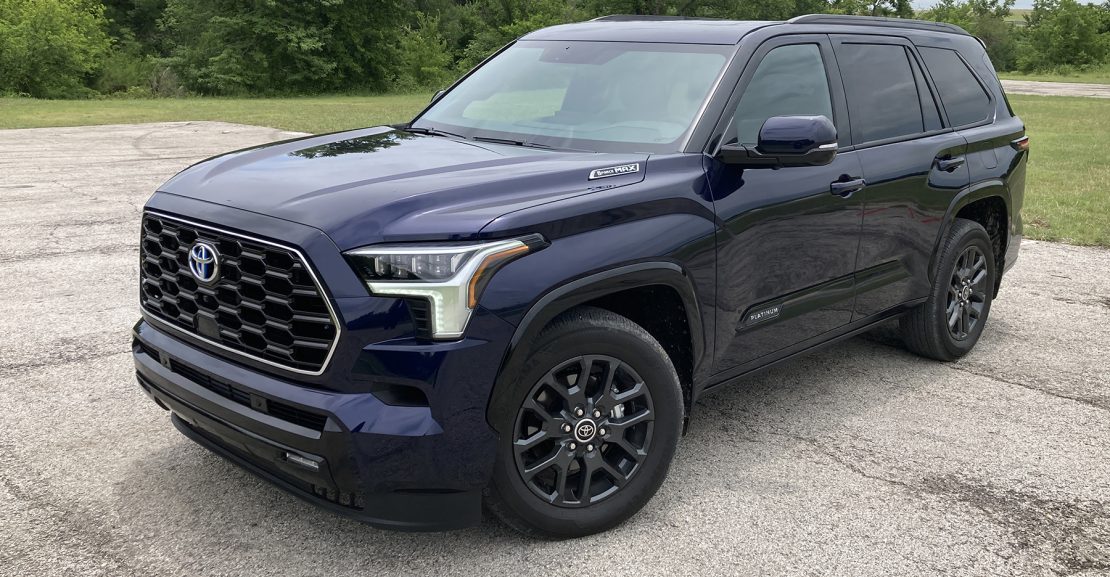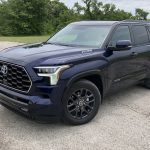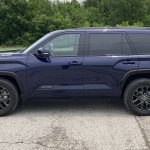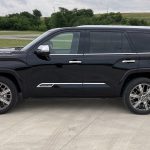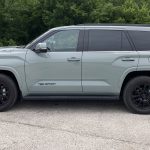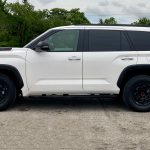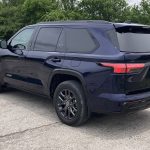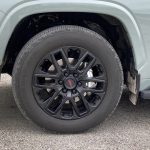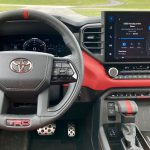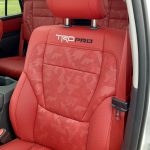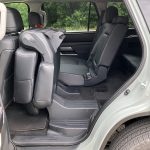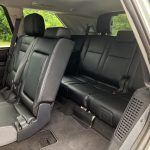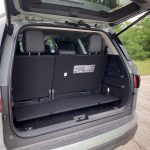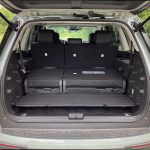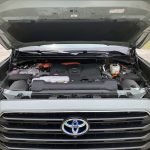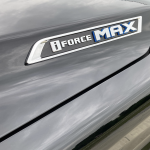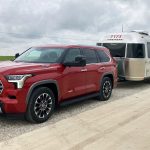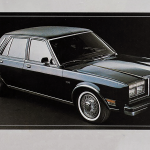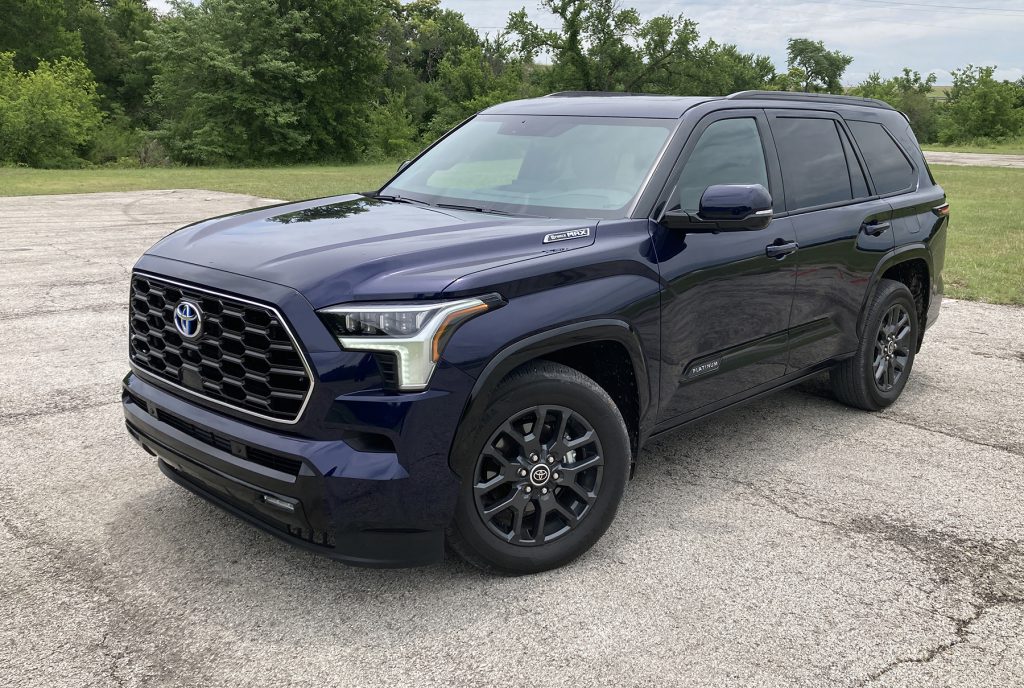

One of the most old-school SUVs on the market is about to get a lot less old-school. It’s been a long time coming, but late this summer an all-new, third-generation version of Toyota’s full-size SUV is slated to go on sale. The Toyota Sequoia is redesigned from the ground up for 2023, finally doing away with its 2008-vintage platform and adopting new body-on-frame architecture that’s shared with Toyota’s redesigned-for-2022 Tundra full-size pickup truck.
Highlights of the Sequoia’s clean-sheet redesign include a standard gas-electric hybrid powertrain, a multi-link rear suspension, a new luxury trim level named Capstone, a third-row seat that slides fore and aft up to six inches, and the latest Toyota Audio Multimedia infotainment system.
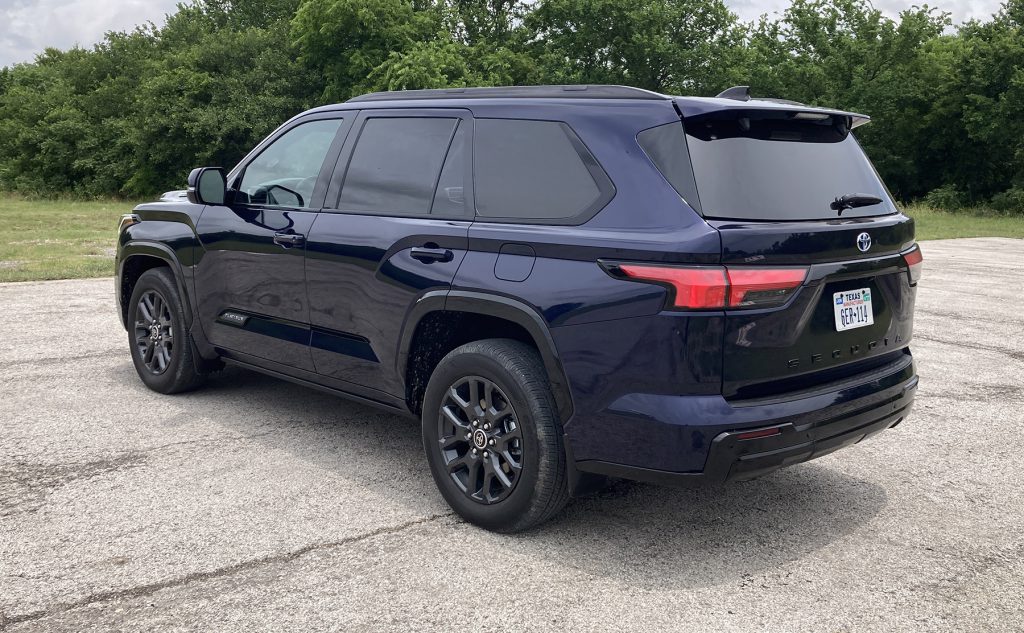
The redesigned Sequoia ditches the old model’s smooth shapes and adopts some of the new Tundra’s bold-and-blocky exterior styling. Once you move past the Tundra front end, the Sequoia’s styling follows classic SUV proportions. A sharp crease below the beltline defines the top edge of the rear wheel bulges before stretching across the liftgate above the horizontal taillamps. As with the Tundra, Toyota’s designers have used different grille inserts and model-specific trim to provide visual distinction between the various Sequoia trim levels.
Compared to the previous-generation model, the 2023 Sequoia’s wheelbase stands pat at 122 inches, but overall length grows by three inches, to 208.1. The rival Chevy Tahoe, Ford Expedition, GMC Yukon, and Nissan Armada big rigs are all within an inch or two of the Sequoia’s dimensions, while Jeep’s new-for-2022 Wagoneer is about six inches longer. However, unlike Ford, GM, and Jeep, Toyota doesn’t offer an extended-length version of the Sequoia.
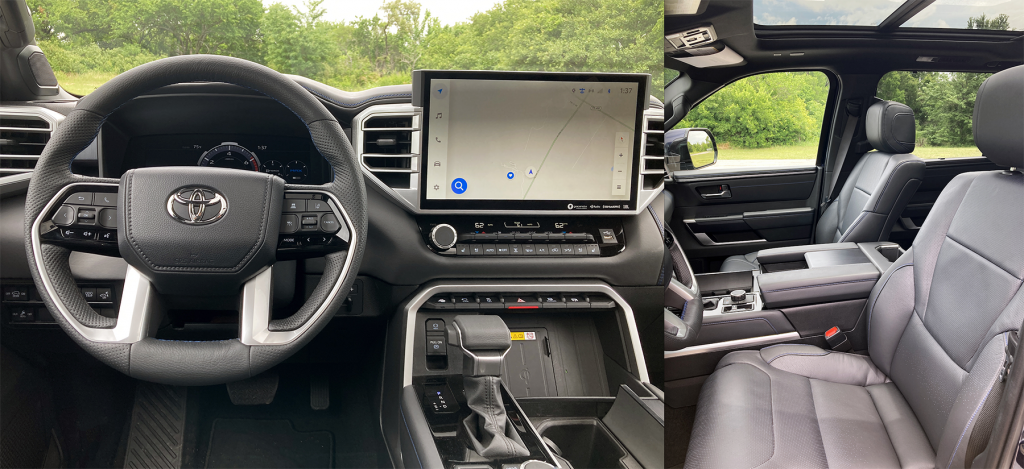
The outgoing Sequoia was powered by a naturally aspirated 5.7-liter V8 engine that put out a healthy 381 horsepower but had an especially voracious appetite for gasoline. The new model switches over to a turbocharged V6 hybrid powertrain—specifically, a twin-turbo 3.5-liter V6 that mates with a 48-horsepower electric motor/generator and a 1.87 kWh nickel-metal hydride battery pack that’s mounted under the third-row seat. Dubbed “i-FORCE MAX,” the hybrid powertrain mates with a 10-speed automatic transmission and is rated at an impressive 437 hp and 583 lb-ft of torque.
Fuel-economy estimates for the 2023 Sequoia are not yet available, but we expect a serious improvement over the 2022 4×4 models’ dismal EPA numbers of 13 mpg city/17 mpg highway/14 mpg combined. The 2022 Toyota Tundra i-FORCE MAX’s EPA mpg numbers are 20 city/24 highway/22 combined with rear-wheel drive and 19/22/20 with 4-wheel drive, so the new Sequoia should be in that ballpark.
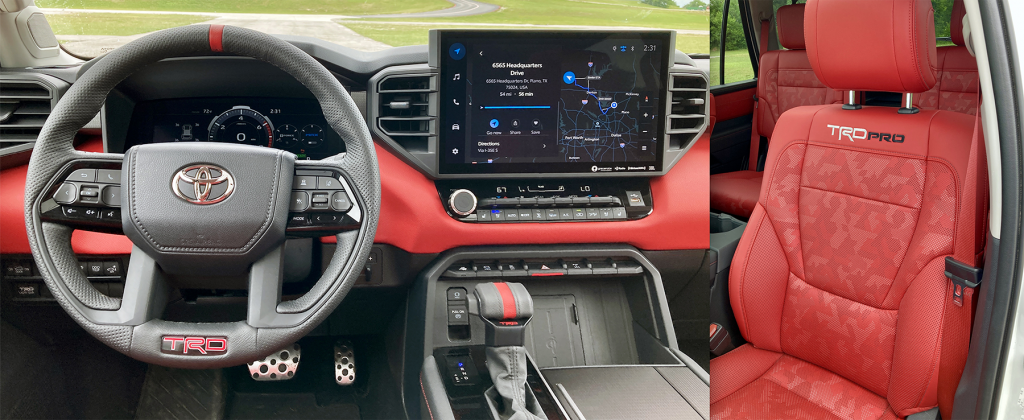
Perhaps not surprisingly, given its standard hybrid powertrain and numerous new technology features, the 2023 Sequoia is a heckuva lot pricier than its predecessor. The lineup starts with the $58,300 SR5 and ascends through Limited ($64,700), Platinum ($70,900), TRD PRO ($76,900), and Capstone ($75,300). Part-time 4-wheel-drive adds $3000 to any Sequoia model (save for the TRD PRO, where it’s standard) and the destination charge tacks on another $1495. The price hike varies by model, but the base SR5 is about $7800 more expensive than last year, and the TRD PRO commands a premium of more than 12 grand over the outgoing model. Oof.
Though the equipment levels vary, the new Sequoia is also spendier to start than most of its class competitors—for example, the base Tahoe LS ($52,000), Expedition XL STX ($53,045), and Armada S ($49,500). It does sneak in $695 lower than the Wagoneer Series I’s starting tab of $58,995. Before any options, Sequoia tops out at $78,300 for a Capstone 4WD, which is right in the thick of it with the Expedition Platinum’s starting price of $79,230 and the Wagoneer Series III Carbide at $78,835.
Test Drive: 2022 Honda Passport Trailsport
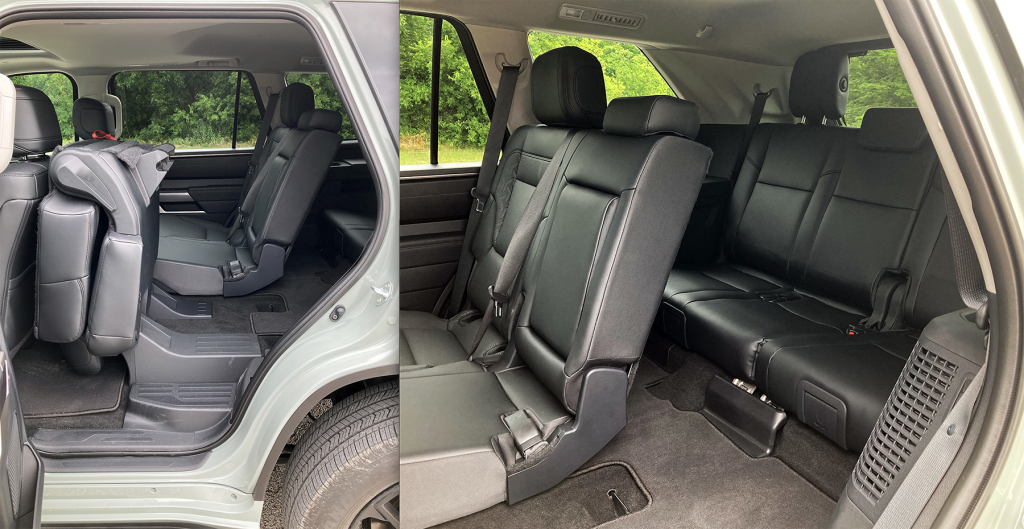
All Sequoias now come standard with a sunroof, heated power-adjustable front seats, a 12.3-inch digital instrument cluster, the Toyota Safety Sense 2.5 suite of active safety features, and the new Toyota Audio Multimedia infotainment system (which you can read more about in our 2022 Toyota Tundra First Spin report).
The entry-level SR5 models include 18-inch alloy wheels, 8-inch touchscreen, three-zone automatic climate control, acoustic laminated windshield, and a fabric-trimmed interior. The available SR5 Premium Package adds “SofTex” leatherette upholstery, 14-inch touchscreen, power folding third-row seats, hands-free power liftgate, and a 120-volt electrical outlet. The optional TRD Sport package adds 20-inch alloy wheels, Bilstein-brand shocks, “TRD SPORT” badging, and specific interior trim. The TRD Off-Road package includes all-terrain tires, off-road suspension, a skid plate, an electronically controlled locking rear differential, Multi-Terrain Select, Crawl Control, Downhill Assist Control, and specific interior/exterior trim.
Test Drive: 2022 Jeep Wagoneer Series II
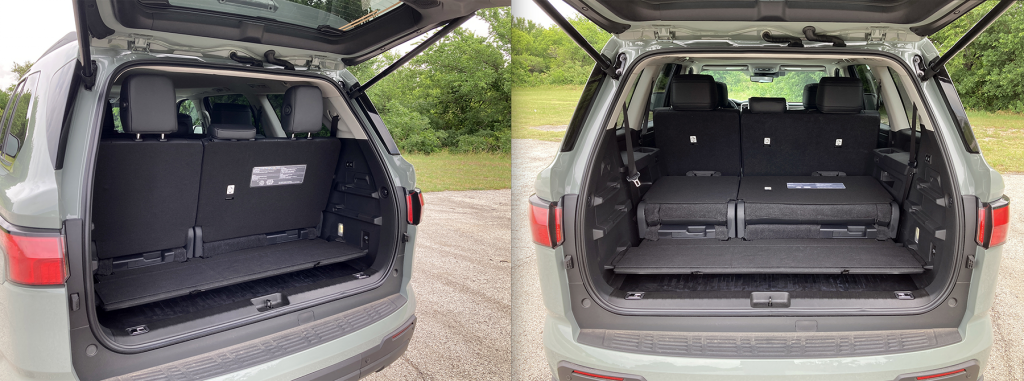
Limited models include 20-inch alloy wheels, SofTex upholstery, power-reclining fold-down third-row seats, a heated steering wheel, and a 14-inch touchscreen. The TRD Off-Road Package is optional on Limited as well. Platinum models add LED taillights with sequential turn signals, rain-sensing wipers, panoramic sunroof, 20-inch black alloy wheels, and leather interior trim.
The TRD Pro model adds the hardware from the TRD Off-Road Package, along with model-specific interior/exterior trim and 18-inch TRD Pro/BBS matte-black alloy wheels fitted with Falken all-terrain tires. The line-topping Capstone trim adds 22-inch alloy wheels, power running boards, and acoustic-laminated front side glass, along with unique upscale interior/exterior trim.
Test Drive Gallery: 2022 Cadillac XT6 Premium Luxury
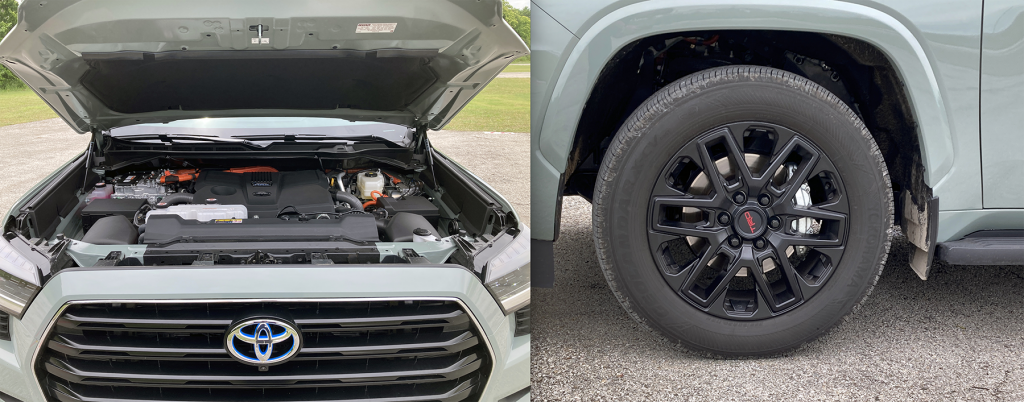
Thanks to its new architecture, the new Sequoia is only slightly heavier than its predecessor (around 50-165 pounds, depending on the model), despite its more complex powertrain and higher level of equipment—the base RWD trim is actually 110 pounds lighter. The curb weights cover a spread from 5620 pounds for a rear-drive SR5 to 6185 for a 4WD Capstone, and that rear-drive SR5 receives Sequoia’s highest tow rating: 9520 pounds. All other Sequoia variants are rated for at least 9000 pounds except for the 4WD Capstone, which comes in at 8980. These ratings fall short of the Wagoneer (10,000 lbs), are right in the mix with the Expedition (9300), and top the Tahoe (8400) and the Armada (8500). A Tow Technology Package with a digital-camera rearview mirror and Trailer Backup Guide with Straight Path Assist is optional on SR5 and Limited models, and standard otherwise. Power extending tow mirrors are optional across the board.
At the 2023 Sequoia’s press-preview event in Plano, Texas, we got seat time behind the wheel of pre-production vehicles in several configurations, including the SR5 TRD Sport, Limited, Platinum, TRD PRO, and Capstone. All Sequoias have an easy-to-read high-resolution 12.3-inch digital instrument cluster that features customizable displays. TRD Pro and Capstone models are available with an optional 10-inch head-up display that projects the speedometer and other information on to the windshield in the driver’s line of sight. The available digital-camera rearview mirror has a crisp, clear video display.
2022 New York Auto Show: 2023 Hyundai Palisade
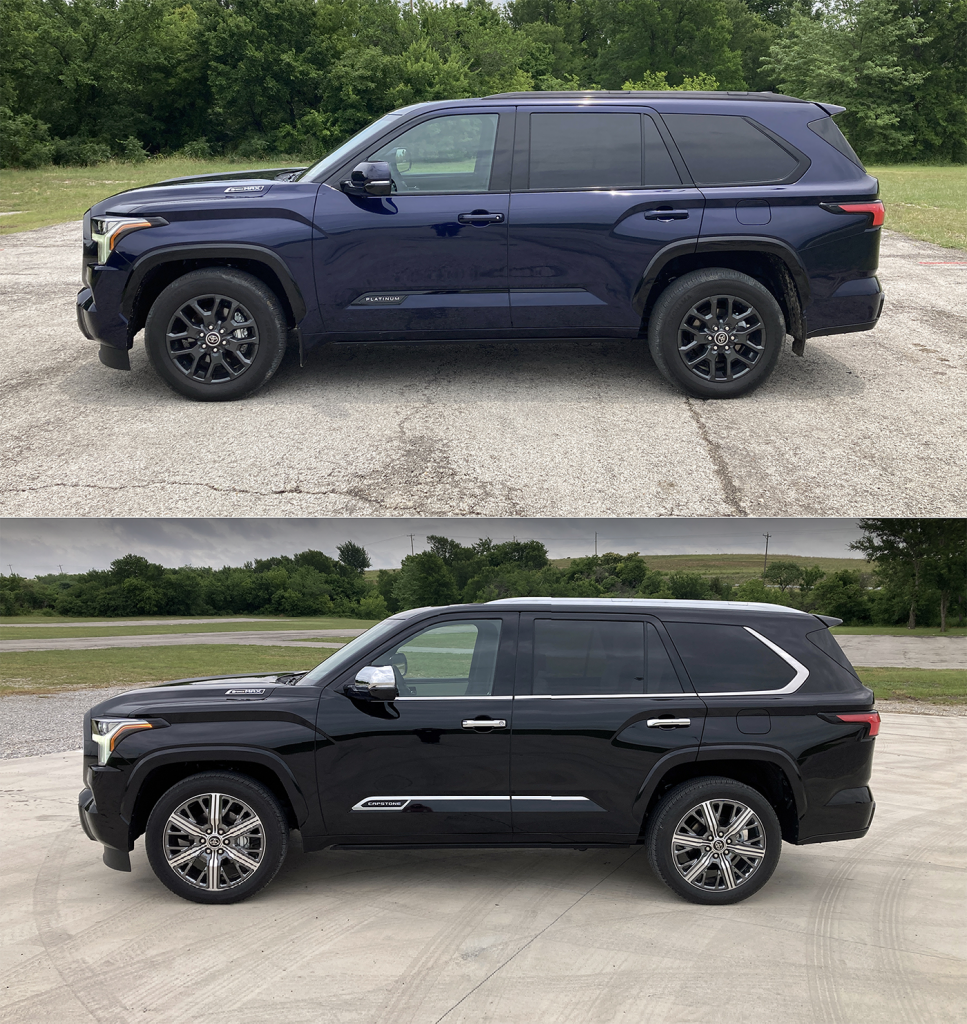
All Sequoias we drove were equipped with the 14-inch Toyota Audio Multimedia touchscreen display that debuted in the new Tundra; its highlights include sharp, easy-to-read graphics and smartphone-like pinch-and-zoom functionality. Certain features, including navigation and audio functions, can be accessed via the integrated voice-controlled Intelligent Assistant. For example, you can say “Hey Toyota, I want to listen to 80s on 8” and that satellite radio station will start playing. In practice, we find the Intelligent Assistant works well and prefer using it rather than navigating through the series of submenus on the touchscreen.
The climate controls and center-console arrangement carry over from the Tundra as well. Directly below the touchscreen is an easily accessible USB-A port, along with a thin horizontal display screen and a row of physical buttons and switches that govern climate control and other functions. The screen is easy to read and the switches are satisfyingly simple “flipper” levers that you push up or down.
A cleverly designed storage cubby resides at the leading edge of the console; its thoughtfully angled smartphone cradle with a built-in wireless charger remains one of the best solutions for in-vehicle phone storage and charging we’ve encountered. The console’s wide armrest covers a large storage bin that’s home to a USB-C port and a second USB-A port accessible via a sliding panel in the armrest.
Even though the cabins of the pre-production models we drove weren’t 100-percent dialed in for the showroom floor, they displayed quality materials and admirable attention to detail. The SR5 TRD Sport interior is naturally the most basic, but its cabin comes across as sporty and purposeful. We particularly liked the SofTex seat trim and its interesting geometrical patterns. The TRD Pro interior in Cabin Red is unapologetically bold, with its eye-searing red SofTex upholstery, “technical camo pattern” seat-upholstery inserts, and oversized raised TOYOTA lettering on the passenger side of the dashboard.
The Platinum model gets dark-finished exterior trim that made for a moody, near-monochromatic look on the example we drove (which was finished in a deep, inky dark blue color called “Blueprint”). Our Platinum’s cabin was finished in black leather accented with unexpected details such as dark blue contrast stitch detailing and brushed gunmetal-finish trim, for a tastefully understated luxury vibe.
The top-line Capstone receives more-traditional chrome exterior trim and an exclusive two-tone black-and-white interior finished in semi-aniline leather (Toyota says these hides are the same premium grade used in the Lexus LS flagship luxury sedan.) As in the Platinum, the Capstone’s leather-wrapped and stitch-detailed dashboard looks fantastic. The dark-finished American Walnut wood trim and white stitch detailing on the black leather are standout details as well.
2022 New York Auto Show: 2023 Jeep Wagoneer L and Grand Wagoneer L
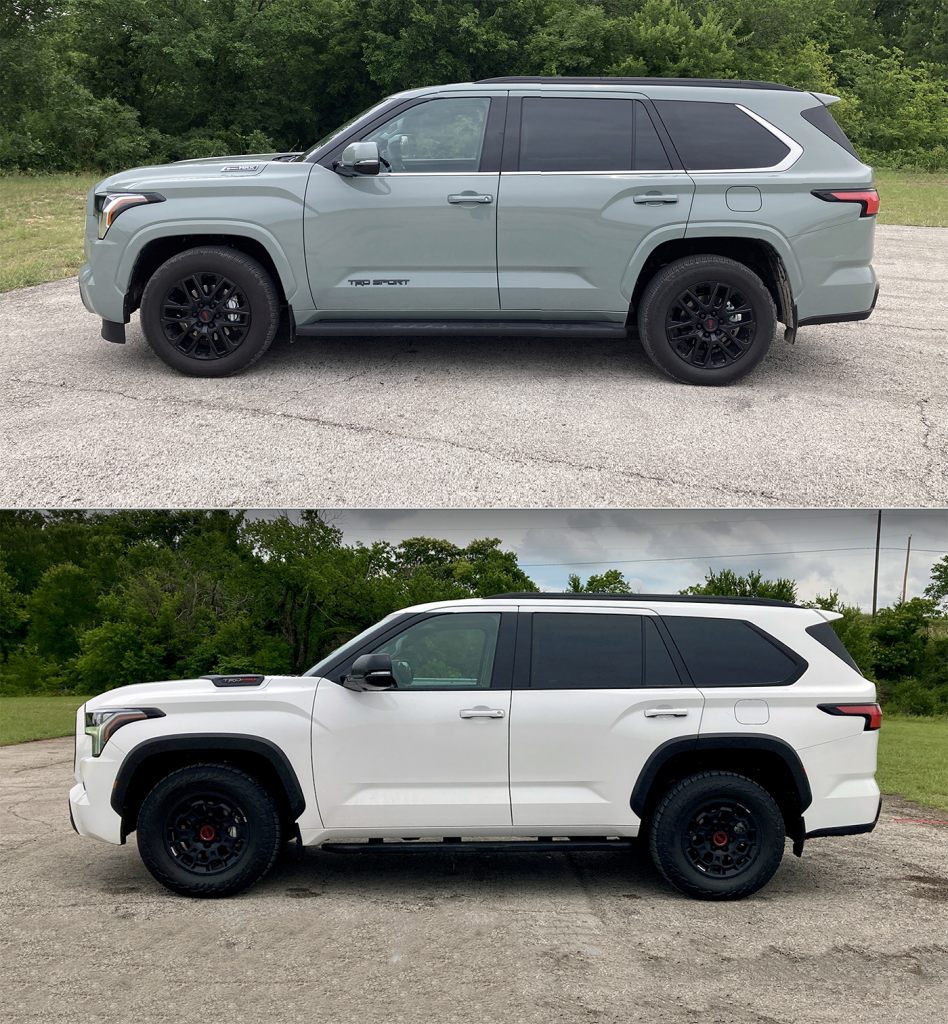
There’s generous space in the Sequoia’s front seats, even for big-and-tall occupants. Running boards help make entry and exit easy; power running boards are standard on Capstone and optional on Platinum. Entry and exit are also easy in the second row. SR5 and Limited models include a 60/40-split bench seat for 8-passenger seating, while all other trim levels provide 7-passenger seating via a pair of second-row captain’s chairs. With either configuration there is ample legroom for most adults, and your 6’2” tester had more than enough headroom. The seats easily fold and tumble forward to open up a wide passage to the third row.
Curiously, the new Sequoia’s second-row seats are NOT adjustable, but its third-row seats are—in most SUVs, it’s the opposite. The third-row seats slide fore and aft up to six inches to favor legroom or the cargo space behind the seats. Passenger space in the third-row seats is class-competitive for the most part—when the seats are slid all the way rearward to free up the maximum amount of legroom. I had just enough headroom in the third row, but my hair was brushing the headliner, and the low seat-bottom cushion results in a knees-up seating stance.
Maximum cargo space behind the third row is 22.3 cubic feet with the seats slid all the way forward—a very respectable number. However, pushing the third-row seats all the way back reduces cargo capacity to only 11.5 cubic feet, and unlike every other class rival, the Sequoia’s third-row seats don’t fold flat into the cargo floor. Instead, the folded seat backs rest several inches above the cargo floor, a compromise necessitated by the placement of the hybrid system’s battery pack underneath the third-row seats. A Toyota spokesman said this location enabled optimal duct venting for cooling the battery pack, as well as easier entry and exit for third-row passengers.
To help compensate for the uneven load floor when the third-row seats are folded, Toyota devised a removable cargo shelf that can be set at one of three levels, the highest of which is just below the bottom edge of the top-hinged opening rear window. This creates a bit of cargo space that can be easily accessed without opening the entire rear liftgate—a handy touch. The shelf also includes fold-over “flaps” that can be used to create a smooth transition from the shelf to the folded third-row seat backs.
With the third row folded, cargo volume grows to 49.0 cubic feet, and folding the second-row seats increases that number to 86.9 cubic feet. Overall, these numbers significantly trail the Tahoe (25.5/72.6/122.9 cubic feet, respectively), Expedition (20.9/63.6/104.6) and Wagoneer (27.4/70.8/116.7), and are also a bit shy of the Armada (16.5/49.9/95.4).
The powerful i-FORCE MAX gas-electric hybrid powertrain is impressively smooth and very refined. It’s very quiet, and transitions between gas/electric and electric-only propulsion are seamless and largely imperceptible. Under a heavier throttle foot, the twin-turbo V6 comes alive with a satisfying growl. The 10-speed automatic is alert and unobtrusive, and it will quickly downshift when more power is requested.
Test Drive Gallery: 2021 GMC Yukon Denali
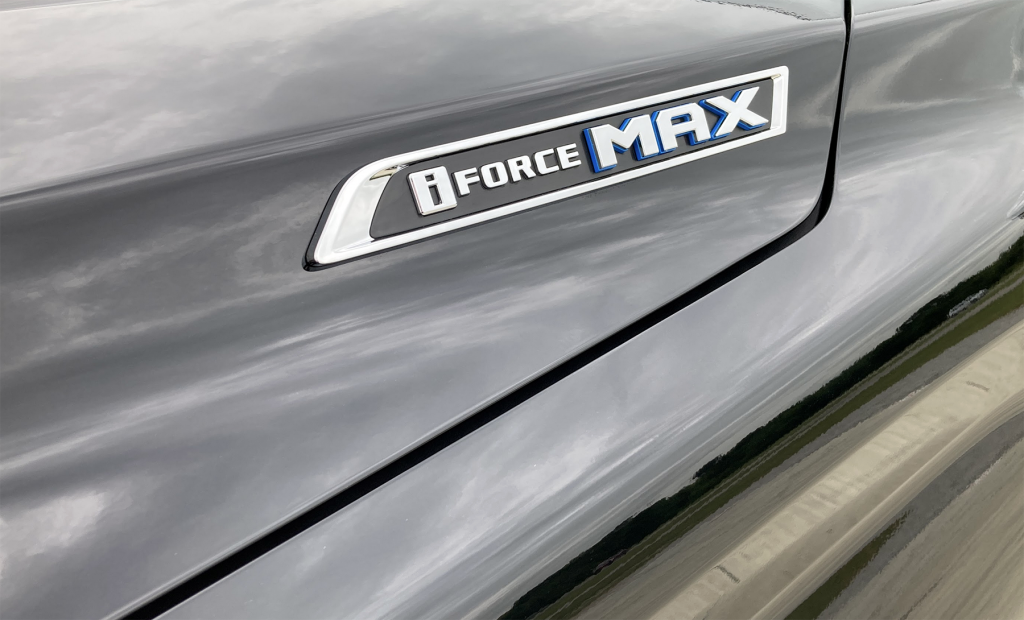
All the Sequoia models we drove on the press preview rode comfortably, with fine bump absorption and a satisfying sense of refinement. The steering is well-weighted and accurate, and body movement is kept in check, but you never forget these are big trucks. Any Sequoia is impressively quiet inside, and even a TRD PRO with its aggressive rubber is relatively serene at 75 mph on the highway. However, our test TRD PRO was missing the standard rooftop cargo platform—we suspect that piece of hardware will be a bit of a noisemaker in highway driving.
The pleasant surprise of our preview drive was the rear-drive SR5 TRD Sport. Almost immediately, it felt more eager and entertaining to drive than the other Sequoias. The TRD Sport package includes specific Bilstein-brand shocks that likely contributed to the more energetic feel, but we’d guess that this truck’s approximately 550-pound weight advantage over the 4WD Capstone played a role as well.
Toyota says they hope to triple the Sequoia’s annual sales volume with the redesigned model. In 2021, the company sold 8070 Sequoias in the United States, so that would mean an output of around 24,000 units a year for the new model. For a rough comparison, the class sales champ is the Chevy Tahoe, which moved 95,725 units in 2021 and in most months beat the old Sequoia’s annual tally.
The redesigned 2023 Toyota Sequoia represents a tremendous upgrade from the dated model it replaces. We’re impressed with the smooth, powerful, class-exclusive hybrid powertrain, and the overall level of refinement. The up-to-date Toyota Audio Multimedia system and comfortable interior are other strong points, as are the very competitive tow ratings. We expect the hybrid powertrain’s real-world fuel economy to be highly competitive as well. You’ll pay a significant premium for all this high-tech hardware, however, and the unconventional, smaller-than-the-class-norm cargo area might turn off its share of shoppers as well. Still, the Sequoia’s overall merits and diverse model lineup make it a compelling new entry in its class.
Test Drive: 2021 Lincoln Aviator Grand Touring
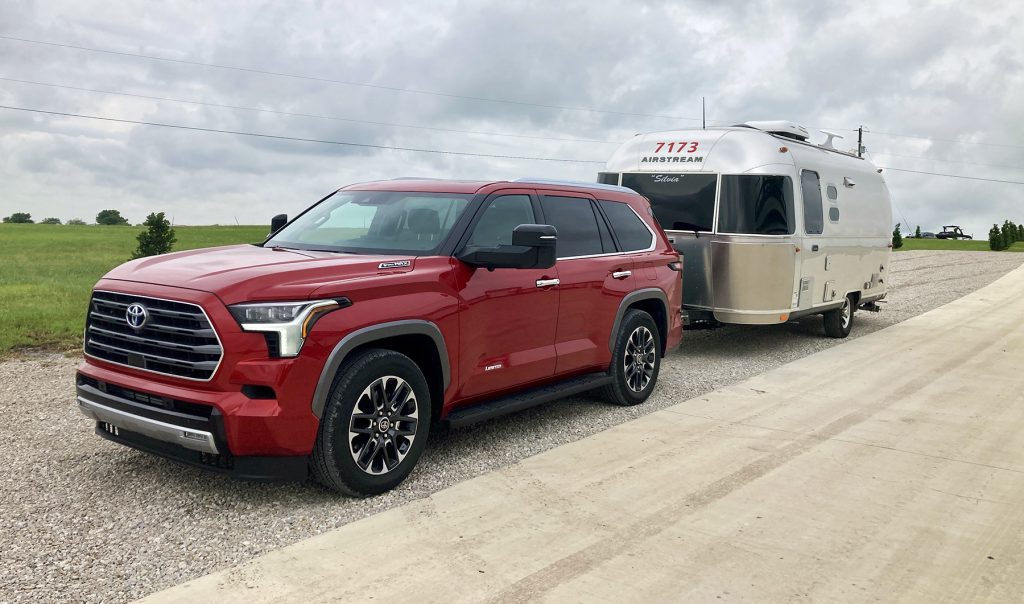
2023 Toyota Sequoia Gallery
Click below for enlarged images
First Spin: 2023 Toyota Sequoia
First Spin: 2023 Toyota Sequoia

